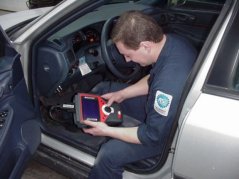Home → Air Quality → Mobile Sources → Enhanced Vehicle Inspection & Maintenance

Enhanced Vehicle Inspection and Maintenance
Need an out-of-state vehicle emissions inspection?
List of inspection stations that do the Class E emissions tests. If you need to provide proof to your home state, be sure to ask the technician to provide you with a copy of the OBD form they fill out during the inspection.
For questions regarding out of state inspections contact Kevin Miller 530-0603.
The OBD forms must be returned within 30 days to the Maine DEP at 17 State House Station, Augusta ME 04333-0017.
If you are a Class E certified inspection station you may request OBD forms from Kevin Miller 530-0603.
Special note: For inspection stations with Inspection sticker questions please email Khyati Bhatt at Public Safety or call (207) 624-8935.
- What is the Enhanced Auto Inspection Program?
- The enhanced motor vehicles inspection program under 29-A MRSA§1751 went into effect January 1, 1999. The program requires that all gasoline-powered motor vehicles registered in Cumberland County be subjected to an enhanced inspection. In January 1999, a gas cap pressure test was added for 1974 and new vehicles. Starting in January 2000 an Onboard Diagnostics (OBD) inspection for 1996 and newer vehicles was added to the inspection. In January 2001, vehicles failing the OBD portion of the inspection were required to make necessary repairs prior to receiving a safety inspection sticker.
- What does OBD have to do with emissions?
- Motor vehicles are the largest source of toxic and smog forming air pollutants in Maine and North America. Newer vehicles are getting cleaner due to newer engine technology and emissions controls, but the emissions are only low if all the engine's controls are in proper working order. When an engine is not operating efficiently, performance is lost, fuel consumption goes up, engine wear and emissions increase. OBD detects problems early and alerts the driver to the need for potential repairs.
- What is OBD?
- Onboard Diagnostic systems are in most cars and light trucks on the road today. Manufacturers started using electronic systems to control engine functions and diagnose engine problems starting in the seventies. Through the years they have become more sophisticated. OBD-II systems introduced in the mid-nineties, provide almost complete engine control and also monitors parts of the chassis, body and accessory devices, as well as the diagnostic control network of the car.
The OBD system monitors all components of the engine management system. It can detect a malfunction or deterioration of the components even before the driver becomes aware of the problem. When a problem is detected that could cause an increase in air emissions, the OBD system turns on a dashboard warning light to alert the driver of the need to have a vehicle checked by a repair technician. - How does the driver know there is a problem?
- When the OBD system determines that a problem exists, a corresponding "Diagnostic Trouble Code" (DTC) is stored in the vehicles computer memory. The computer illuminates a dashboard light indicating "Service Engine Soon" or "Check Engine" or displays an engine symbol. This light serves to inform the driver that the computer has detected a problem and the vehicle needs service. By federal law this light can only be used to indicate an actual problem. The light cannot be used as a reminder for regular maintenance.
- How is the light turned off?
- After fixing the problem, the service technician will turn off the dashboard light. There are some situations under which the vehicles OBD system can turn off the light automatically, if the conditions that caused the problem are no longer present. For example, if the OBD system evaluates a component or system, three consecutive times and no longer detects the initial problem, the dashboard light will turn off automatically. As a result, drivers may see the dashboard light turn on and then turn off.
- Who can service OBD related problems?
- Only qualified trained technicians equipped with appropriate diagnostic and repair equipment should conduct OBD related repairs. With the population of modern technology cars growing, all dealerships and independent repair shops should have qualified personnel for this service. Vehicle owners should ask service facilities if they have the necessary training and equipment.
Exemptions to Readiness Status For questions contact Kevin Miller 530-0603